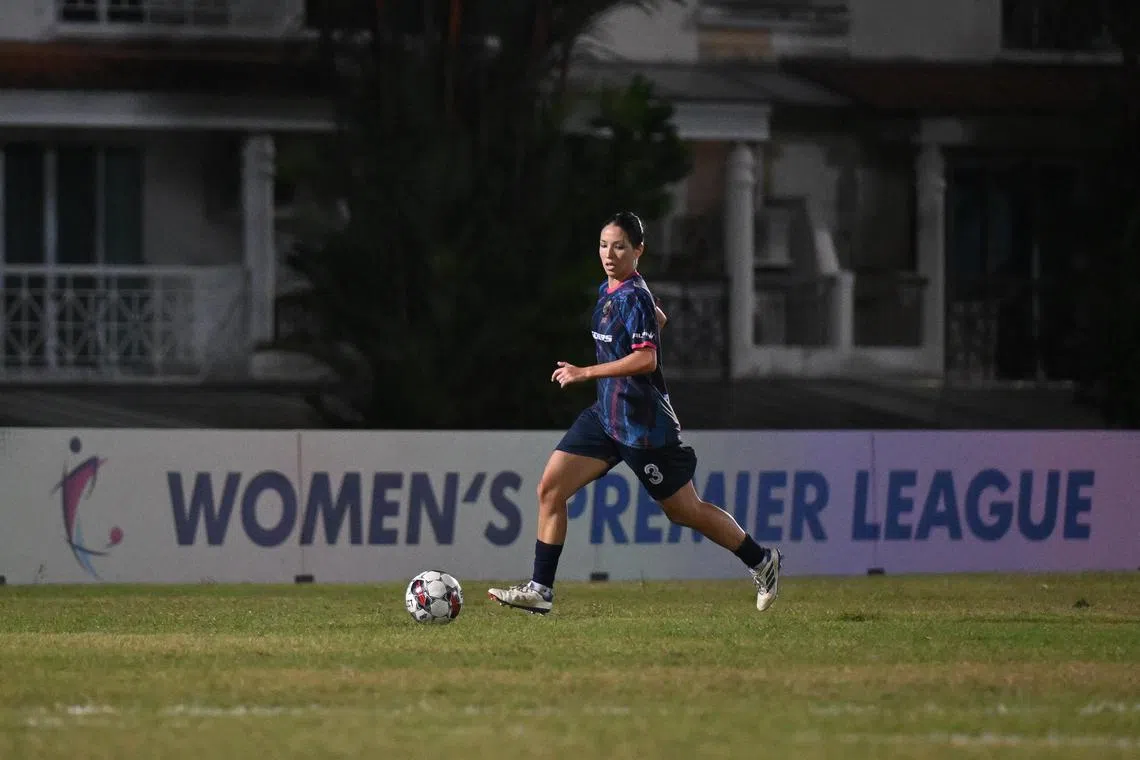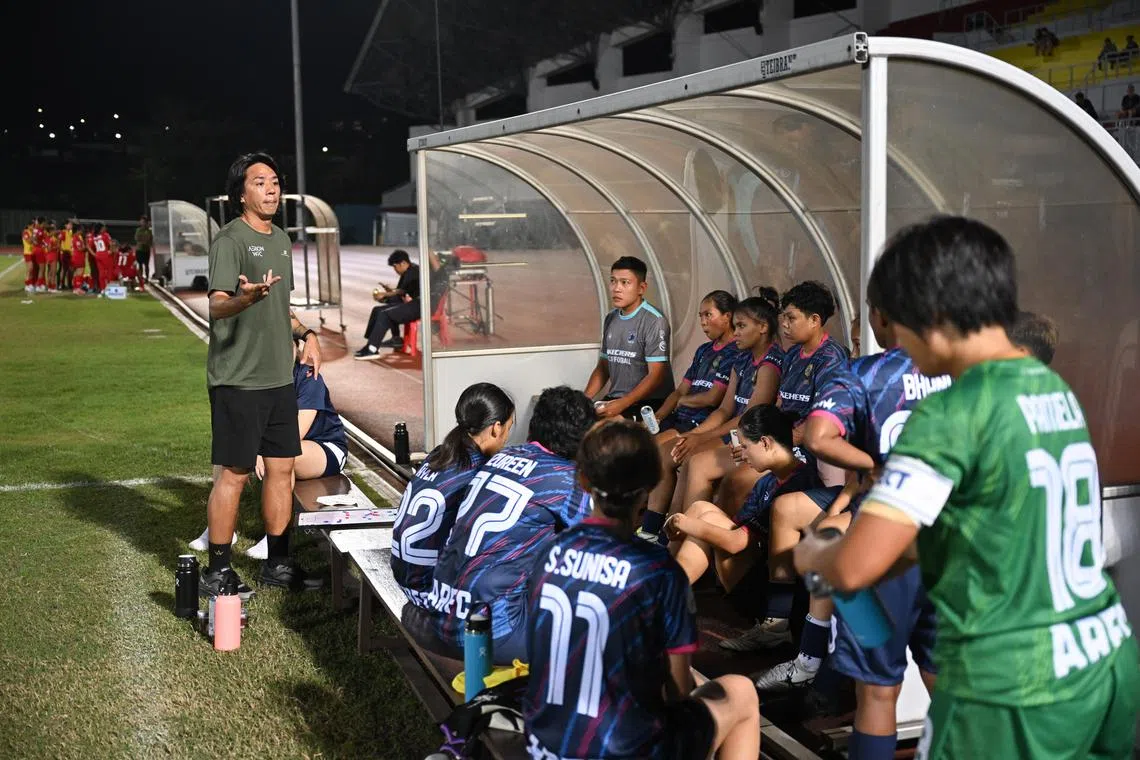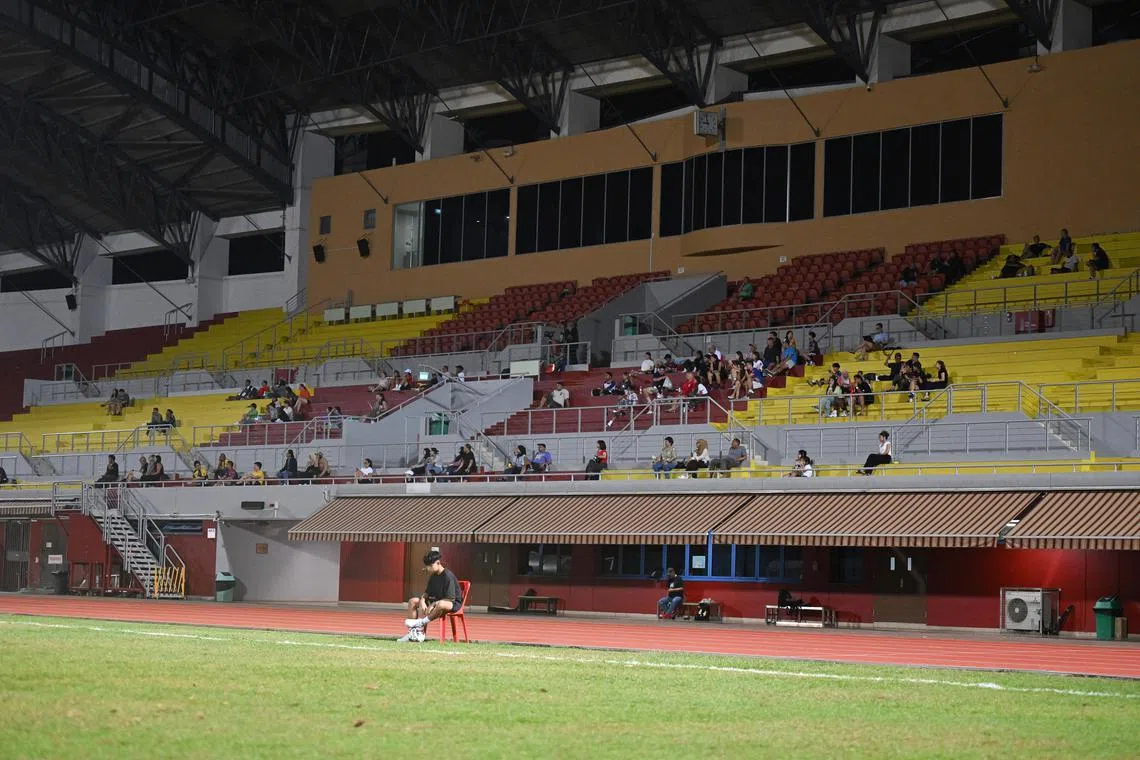Can Women’s Premier League take off after losing title sponsor? FAS upbeat but issues remain
Three years after the Women’s Premier League’s watershed moment with the announcement of a three-year sponsorship deal with professional services firm Deloitte, it entered the 2025 season without a title sponsor. The WPL’s issues, both on and off the field, have been reported over the years, but have things improved? The Straits Times speaks to players, coaches and officials involved in the local women’s football competition to find out its current state.
Sign up now: Get the biggest sports news in your inbox

Things worsened ahead of the 2025 season when Deloitte decided not to extend its sponsorship.
ST PHOTO: SHINTARO TAY
Follow topic:
SINGAPORE – When the Women’s Premier League (WPL) returned in 2022 after a two-year pandemic-enforced hiatus, it relaunched to fanfare as Deloitte was unveiled as its title sponsor.
The professional services firm signed a three-year deal worth over $300,000, with an option for a two-year extension, marking the league’s first title sponsorship since its inception in August 2000.
It seemed to signal a new era for women’s football here, but the initial excitement has since faded, with the league still facing several challenges, from sub-par match-day facilities to limited exposure.
Things worsened ahead of the 2025 season, which kicked off on March 1, when Deloitte decided not to extend its sponsorship, leaving the WPL without a title sponsor.
While players and officials interviewed by The Straits Times noted that there have been improvements in the league over the past three years, many believe significant issues remain. Losing a title sponsor has left some concerned about the WPL’s future.
Still Aerion midfielder Lila Tan acknowledged that Deloitte’s support had enhanced the league’s overall experience and professionalism, and hopes for new sponsors to come in.
She said: “Deloitte has been a massive support over the few years for WPL and, without our biggest sponsorship, I’m not too sure how the league is going to progress from here.”
Asked about Deloitte’s decision, James Walton, sports business group leader of Deloitte Asia Pacific and South-east Asia, said: “When you’re talking about sponsorships and partnerships, it is about the brand, the eminence, and the outreach that you are achieving.
“We did a review, had some discussions with FAS (Football Association of Singapore) around what the expectations, the directions, are for the next couple of years, and we just decided at this point in time that with the other things that we have coming down the line, it would be difficult for us to continue to commit to this (WPL).”
Walton added that when Deloitte signed the deal, it was to help relaunch the league and give it a platform to shine on and now, there is “an opportunity for someone else to take it forward”.
FAS general secretary Chew Chun-Liang credited Deloitte for helping to develop the league and elevate the profile of women’s football in Singapore, which have contributed towards building a pipeline of players for the national team.
While acknowledging that “there is still room for improvement”, he reaffirmed the association’s commitment to the league. The competition’s prize pool remains unchanged for 2025, with the league champions set to receive $25,000, while the first and second runners-up will be awarded $10,000 and $7,500 respectively.

Lila Tan in action for Still Aerion in their 2-2 draw with BG Tampines Rovers during a Women’s Premier League match at Choa Chu Kang Stadium on March 2, 2025.
ST PHOTO: SHINTARO TAY
Some progress made
One of the areas that has seen improvement is the increased investment in women’s football.
In 2022, the FAS introduced several initiatives to lift the league, including a club licensing system for women’s teams and grants to support coaching hires, player allowances and travel expenses.
Seven of the nine Singapore Premier League clubs – except for foreign outfit Brunei DPMM and developmental side Young Lions – now have teams competing in the WPL, creating a more unified structure.
From seven teams in 2022, the competition expanded to 10 sides the following year before becoming nine for the 2024 and 2025 campaigns.
Geylang International defender Nadhra Aqilah believes the greater recognition of the women’s teams by clubs has led to better staffing resources for WPL sides.
The 30-year-old said: “Previously, we only had a head coach, but now we are guaranteed a goalkeeper coach and a physiotherapist as well. Knowing we have these resources in place translates into our game; we want to show on the pitch what people hear about our progress.”
Greater investment in the form of improved allowances, foreign player signings and overseas trips have also raised the quality of the league, with more young and technically skilled players emerging.
Former Lionesses captain Ernie Sulastri, who plays for Still Aerion, noted there has been a greater focus on player development and youth programmes.
She said: “This demonstrates a real commitment to nurturing talent and providing opportunities for women to play at the highest level.”
Lion City Sailors goalkeeper Beatrice Tan added that competition has intensified with the introduction of a pathway to the new Asian Football Confederation (AFC) Women’s Champions League in the 2024-25 continental season. The Sailors – who have won three consecutive titles – represented Singapore in the AFC competition.
These developments have led to greater awareness of the league and women’s football, said Ernie, 36.
She added: “It’s exciting to see more young girls inspired to play, knowing they have role models and a clear pathway in the sport.”

Still Aerion Women’s coach Jeremy Chiang speaking to his players at the break during their 2-2 draw with BG Tampines Rovers in a Women’s Premier League match at Choa Chu Kang Stadium on March 2.
ST PHOTO: SHINTARO TAY
Problems to fix
While there is an increase in young females picking up the sport, Yeong Sheau Shyan, head of the Sailors women’s programme, is concerned by the recent development of losing some of these talented players to the Singapore Youth League (SYL).
The youth competition, spanning age groups from Under-8 to U-17, features eight girls’ teams – five from the Junior National Development Centre and three from the National Development Centre – in the boys’ leagues.
They compete against boys who are at least one age group lower.
While the NDC girls are allowed to play in the WPL once they reach 15 – the minimum age to be registered as a WPL player – the coaches of the respective teams must assess if the players can compete in both competitions to avoid injury due to overloading.
Previously, the league also permitted girls under 16 to play, subject to approval through a technical assessment, but this has been excluded from the latest regulations.
Yeong said that the FAS technical department had deemed that the WPL’s quality was too low and not suitable for their development, a decision she feels will benefit only a handful of girls, making it difficult to build a strong talent pool.
She said: “The WPL has become a lot more technical and entertaining with the inclusion of younger girls who received more organised training than the older players before, but now they have the NDC girls in the SYL instead which has dampened things for the WPL. It is a sad thing for women’s football.
“We cannot say our WPL is low quality and not do anything about it but instead just pull the players out into a youth boys’ league.”
“The best of the girls should play against boys but they should also participate in the WPL and play a part in growing their own community. Otherwise, the only girls who benefit are the top 15 to 20 girls in their age groups while the rest are getting subpar competition. It is not possible to build a big enough competitive pool like this,” she added.
Other concerns raised by players include “basics that have not been fulfilled”.
In 2022, ST reported problems faced by WPL players, including poor pitches and insufficient changing rooms. Improvements were made – with matches moved to a centralised venue at Choa Chu Kang Stadium, where there are sufficient changing rooms and sheltered dugouts.
But the pitch remained a serious issue in 2024 as it suffered from having two back-to-back matches every Saturday or Sunday, sometimes on both days, as players hit out at what they deemed a “plantation field”. Almost all matches in 2025 will continue to be played at Choa Chu Kang.
Lila Tan said: “There’s a lot to improve on. Some things can be seen as rather trivial aspects, but they do play an important part in football. For instance, when a passer-by comes to sit down and watch. It doesn’t seem very professional or appealing to have players sit on a literal bench where players are often squeezed together or when there’s no scoreboard displayed during the match.”
A fan who attends WPL matches regularly said the “scoreboard is quite critical because (not having it) degrades the game-watching experience significantly”. He added: “We would have to ask other members of the audience if we missed a play or came late, but even then, no one is 100 per cent sure of the score.”
A WPL player who declined to be named called on the authorities to ensure the pitch is well-maintained for the season. She revealed that concerns over poor pitch conditions have resulted in players not giving 100 per cent in matches to avoid injuries.
She added: “We don’t really pressure people or the management – we don’t say we want to play at Jalan Besar Stadium and we don’t ask for better pitches that the men play on, we just want a place that is safe for us to play. It’s more of if we play here why is it not properly maintained?”

A WPL player who declined to be named called on the authorities to ensure the pitch is well-maintained for the season.
ST PHOTO: SHINTARO TAY
More needed off the field too
The fraternity also believes that much more can be done to raise awareness of the WPL, with Yeong assessing that there was a “lack of hype”, pointing to the absence of marketing and regular social media updates.
Average attendance figures for the WPL has dropped from 98 in 2022 to 64 in 2023, with a slight increase to 71 in 2024. The total attendance for the 2022 season was 4,098, when it was a seven-team competition with a total of 42 games. In 2023, the figure was 5,721, when 10 teams took part in a 90-game campaign, with 5,105 fans in attendance for the 72 matches in the nine-team season in 2024.
Sailors goalkeeper Beatrice Tan and others that ST spoke to painted a sombre picture of what match days look like on weekends. One fan estimated that there are usually about 40 to 60 people in the stands.
“The overall match attendance remains stagnant,” said Tan, who added that there has been an increase in dedicated fan bases for a few clubs.
“Most matches now take place in somewhat empty stadiums, (which is) a huge contrast to the lively atmosphere of the 2022 season.”
Players have also hit out at the lack of live-streaming for matches although match highlights are available.
An official involved in the women’s game, who spoke on the condition of anonymity, raised the question of why WPL matches are not scheduled before SPL matches at the same venue on weekends and marketed as “double-headers”. This, the official suggested, could provide an opportunity for the women’s game to attract the supporters attending the men’s match.
The official added: “What are they (FAS) doing to promote the women’s game when they don’t have a match happening? They should be promoting the players and the clubs.”
The WPL Instagram page was dormant from October 2024 to February 2025.
The official also pointed out that while staff involved in women’s football have frequently assisted with the men’s game, the reverse is not often the case. The official suggested that FAS allocate dedicated staff to focus on the women’s game and added: “It is very clear that women’s (footballers are) still second-class citizens by a long shot.”
It is a call seconded by Ernie, who said there is still a need for “more investment in facilities, training centres and support staff specifically tailored to the women’s game”.
Looking ahead
The 2025 season promises to be an exciting one, with three international competitions – the Asian Cup qualifiers, the Asean Women’s Championship and December’s SEA Games in Thailand – lined up for the Lionesses.
While they have an overseas-based talent pool comprising players such as Danelle Tan, who is with Brisbane Roar, and Unleash The Roar! scholarship holders in Spain and United States, the bulk of the squad comes from the WPL.
But Chew is optimistic of the future as he highlighted upcoming initiatives.
In April, the Roar will visit the Republic for a five-day tour, which includes an exhibition match against a WPL All-Star team. The FAS also announced a new Under-16 girls’ category for the Lion City Cup, an annual international youth competition.
Chew said that the inaugural Breast Cancer Foundation Charity Cup that was held on Feb 22 at the Jalan Besar Stadium, where girls and women’s tournaments were organised, was one where “between sponsors, donors and partners, more than 10 brands came on board our event”. He added that there are “several ongoing conversations that give us confidence that there is much support for women’s football in Singapore”.
“We must sincerely thank Deloitte for their support over the last three years, their commitment to the cause was tremendous. We are excited about what possibilities lie ahead, and we are optimistic.”
Deepanraj Ganesan is a sports journalist at The Straits Times focusing on football, athletics, combat sports and policy-related news.
Kimberly Kwek joined The Straits Times in 2019 as a sports journalist and has since covered a wide array of sports, including golf and sailing.

